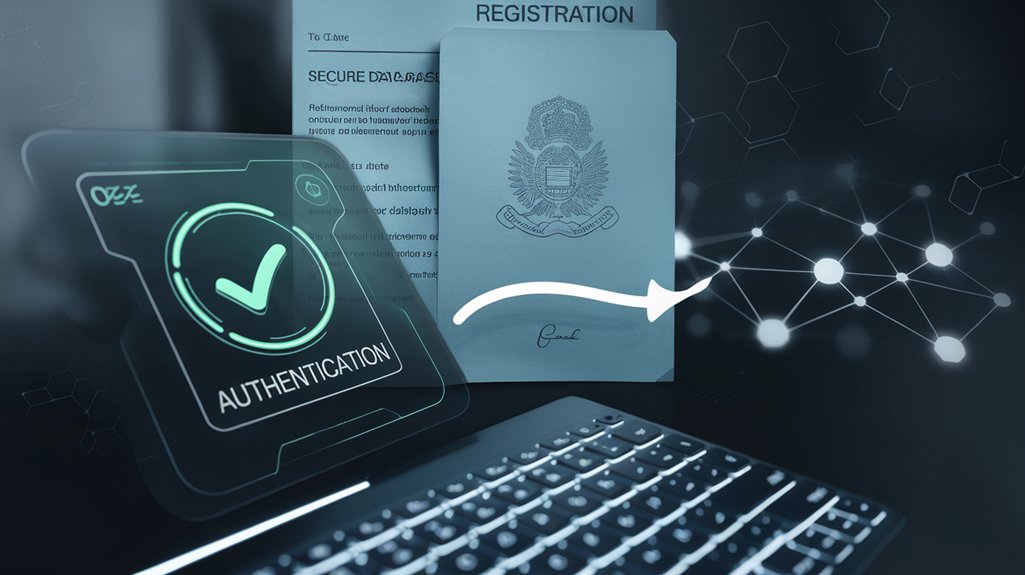UEI validation through SAM.gov verifies entity identity for federal contracting eligibility. The process requires accurate documentation showing legal name and physical address, with common validation challenges including address mismatches and outdated information. When validation fails, entities must create an incident ticket, submit supporting documents less than five years old, and monitor progress via the Status Tracker tool. P.O. boxes are not acceptable for physical addresses. Proper documentation preparation greatly improves validation success rates.
Understanding UEI Validation Requirements

When registering to do business with the federal government, entities must obtain a Unique Entity Identifier (UEI) through SAM.gov as part of the validation process. This verification confirms an entity’s identity before it can engage in federal contracting opportunities, establishing essential compliance considerations for all prospective contractors.
The verification requires specific documentation types that verify the entity’s legal name and physical address. These typically include stamped official filings from recognized authorities, such as incorporation papers or business certificates. The Entity Administrator must create login credentials for SAM.gov before beginning the registration process.
UEI verification demands formal documentation from recognized authorities to confirm an entity’s legal name and physical location.
For international entities, additional requirements include obtaining an NCAGE code before completing registration.
Entities must prepare for annual verification requirements, as UEI verification occurs during initial registration and each subsequent renewal. When making changes to business information, such as legal name or address updates, revalidation becomes necessary.
Maintaining current documentation ensures seamless compliance with federal registration standards and prevents delays in contract eligibility. This transition from DUNS numbers to UEI represents a significant system improvement for entities seeking federal funding opportunities through Grants.gov and related portals.
Navigating the Entity Match Confirmation Process

The Entity Match Confirmation Process represents a key checkpoint in the UEI validation journey for federal contractors. During this phase, SAM.gov’s Entity Validation Service automatically compares submitted information against external databases to verify accuracy and legitimacy.
When the system successfully matches your business details, validation proceeds smoothly. However, if the automated matching algorithm fails to confirm your entity information, you’ll need to create an incident in the system and submit supporting documentation.
Common reasons for match failures include:
- Inconsistent or misspelled business names
- Outdated physical addresses
- Incorrect incorporation dates or state information
- Missing required fields in your submission
To monitor your validation progress, utilize the Status Tracker tool within your SAM.gov account. The system sends email notifications about your status and any required actions. Registration processing typically takes up to 3 business days with additional time for external reviews.
For successful entity verification, verify all submitted information precisely matches your official business records before initiating the validation process. Remember that using P.O. boxes for your physical address will result in rejection of your validation request.
Addressing duplicate entries promptly is essential to prevent delays in the validation process and maintain compliance with SAM requirements.
Resolving Validation Challenges With Documentation

Tackling documentation challenges represents the most critical phase in the UEI validation process for many federal contractors. When facing rejection, organizations must understand common rejection scenarios and apply documentation best practices to resolve discrepancies efficiently.
The manual review process, which affects 15-20% of entities, requires meticulous attention to document accuracy requirements. Since the GSA transition from DUNS to UEI in April 2022, documentation must be less than five years old to be considered valid. Creating an incident ticket through SAM.gov is essential when submitting documentation for manual review.
Successfully maneuvering validation challenges typically involves:
- Submitting notarized corporate resolutions that clearly demonstrate ownership changes, ensuring all signatures and dates match official records.
- Providing secondary verification documents such as utility bills or lease agreements when address discrepancies trigger validation failures.
- Including appropriate certification documents that align with your entity type (IRS determination letters for nonprofits, merger certificates with effective dates).
Organizations experiencing validation delays should examine their submission for common rejection causes, particularly address mismatches between SAM.gov entries and official USPS/state records, missing tax ID suffixes, or unsubstantiated DBA name usage. Maintaining an active SAM profile is crucial for continued eligibility to pursue federal contracts and grants after completing the validation process.
Frequently Asked Questions
How Long Does the UEI Validation Process Typically Take?
The UEI validation timeline typically takes 7-12 business days with complete documentation, though recent system changes have extended this process.
Many entities now experience 4-6 week UEI processing periods due to updated validation protocols.
Factors affecting duration include documentary completeness, CAGE code verification, and IRS TIN matching.
For best results, organizations should initiate registration or renewal 60+ days before needed, monitor status regularly, and guarantee all submitted information is accurate and consistent.
Can Multiple Administrators Manage a Single Entity Registration?
Yes, multiple administrators can manage a single entity registration in SAM.gov. The system supports multiple user roles with entity management permissions to guarantee operational continuity.
Organizations can assign several Entity Administrators to maintain access during personnel absences or changes. This redundancy prevents workflow disruptions when registrations need renewal.
There is no numerical limit on administrators per entity, though all administrators must be active employees, officers, or board members of the organization, not third-party contractors.
What Happens if My Entity Moves After UEI Validation?
When an entity relocates after UEI validation, the UEI number itself remains valid, but the entity must update its information in SAM.gov.
The registration update process requires logging into SAM.gov with a Login.gov account and modifying the entity’s address details.
Failing to update this information may result in communication issues, delayed contract awards, or compliance problems.
Entity administrators should complete these updates promptly to maintain accurate records and guarantee continued eligibility for federal opportunities.
Are Tribal Entities Subject to Different Validation Requirements?
Tribal entities must meet the same validation requirements as all other organizations seeking federal contracting opportunities.
Despite common misconceptions, tribal organizations receive no exemptions from UEI validation processes or documentation standards. They must provide identical proof of identity, TIN verification, and address confirmation.
Regulatory compliance for tribal entities follows standard federal guidelines, requiring complete SAM.gov registration and adherence to all validation protocols established by the federal government’s Integrated Award Environment.
How Do I Transfer UEI Ownership During Company Acquisition?
During company acquisitions, the UEI transfer process requires updating the entity profile in SAM.gov to reflect new ownership.
Companies must submit ownership documentation, including acquisition agreements and notarized letters verifying the change.
Contact the Federal Service Desk with this documentation to process the transfer.
Complete this process promptly to maintain federal contracting eligibility.
Keep all records of the transfer for future reference.
The same UEI typically continues unless otherwise instructed by federal authorities.